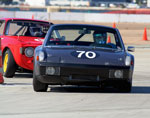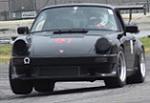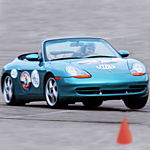Scratch repair?
16 posts
• Page 1 of 2 • 1, 2
Scratch repair?
A few months ago some lovely person decided to key my truck. I was thinking about trying one of the scratch removers. Internet research shows the Quixx seems to work pretty well. Anyone used this or any other product and have advice. Not trying to win a concourse with the truck, but would be nice if the scratch was less apparent. I know the paintless dent removal works miracles, does this?
Jad Duncan
997 S Cab - Sold
996 "not a cup car" Sold
Tesla Model S
Porsche Taycan
https://www.goldfishconsulting.com/
997 S Cab - Sold
996 "not a cup car" Sold
Tesla Model S
Porsche Taycan
https://www.goldfishconsulting.com/
-

Jad - Pro Racer
- Posts: 1788
- Joined: Wed Jun 30, 2004 11:03 am
- Location: Del Mar
Re: Scratch repair?
I have used the Mequiars Scratch removal product on both light and dark cars with pretty good success. I would suspect if the keying is deep, you won't see any benefit. Remember not to rub too hard, as the "scratch removal" product will then create very small fine scratches (esp on clearcoat)! Be generous with the wax afterwards. Also have tried the turtle wax colored wax which came with a small color stick to fill in the bigger areas. Definately will pass the 50/50 rule (50ft or 50mph).
Brian Harnish GP #815
Current: 08 Cayman S, 87 944 S, 87 944.
Past: 81 911SC, 83 944, 86 944, 82 924T, 97 993, 84 944, 87 944, 83 944, 04 Cayenne S, 81 924T, 01 Boxster S.
Current: 08 Cayman S, 87 944 S, 87 944.
Past: 81 911SC, 83 944, 86 944, 82 924T, 97 993, 84 944, 87 944, 83 944, 04 Cayenne S, 81 924T, 01 Boxster S.
-

harnishclan - Time Trialer
- Posts: 343
- Joined: Fri Jul 09, 2004 10:10 am
- Location: Lubbock, TX
Re: Scratch repair?
Jad,
In addition to what Brian has posted, if the scratches are deep, you might try Dr. Colorchip. It is more expensive but fills in the holes with actual paint and does a good job.
In addition to what Brian has posted, if the scratches are deep, you might try Dr. Colorchip. It is more expensive but fills in the holes with actual paint and does a good job.
Chuck Sharp
1988 911 Carrera 3.2 Targa C.E.
1988 944 Turbo S
1986 944 Spec
and Several X Cars
1988 911 Carrera 3.2 Targa C.E.
1988 944 Turbo S
1986 944 Spec
and Several X Cars
-

ChuckS - Time Trialer
- Posts: 471
- Joined: Tue Apr 03, 2007 4:03 pm
- Location: Rancho Bernardo
Re: Scratch repair?
Yep,
I've seen that "Dr Colorchip" stuff work pretty good.
John
I've seen that "Dr Colorchip" stuff work pretty good.
John
Last edited by John Straub on Wed Dec 16, 2009 12:35 pm, edited 1 time in total.
John Straub...56 year member...PCASDR
1965 911
1967 911
1970 914/6GT,(Sold)
Websitehttp://www.JohnStraubImageWorks.com
1965 911
1967 911
1970 914/6GT,(Sold)
Websitehttp://www.JohnStraubImageWorks.com
-

John Straub - Club Racer
- Posts: 991
- Joined: Wed Jun 30, 2004 3:13 pm
- Location: La Mesa
Re: Scratch repair?
Talk to Dan Chambers. He has a "scratch" repair in progress on his SC.
Gordon Carter
'71 911 #56
'71 911 #56
-

gocart - Time Trialer
- Posts: 218
- Joined: Wed Sep 24, 2008 2:42 pm
Re: Scratch repair?
Thanks for the input. Some places the keying is deep, showing primer through, so maybe a paint matching product might be best.
Dan???
Dan???
Jad Duncan
997 S Cab - Sold
996 "not a cup car" Sold
Tesla Model S
Porsche Taycan
https://www.goldfishconsulting.com/
997 S Cab - Sold
996 "not a cup car" Sold
Tesla Model S
Porsche Taycan
https://www.goldfishconsulting.com/
-

Jad - Pro Racer
- Posts: 1788
- Joined: Wed Jun 30, 2004 11:03 am
- Location: Del Mar
Re: Scratch repair?
Jad wrote:Thanks for the input. Some places the keying is deep, showing primer through, so maybe a paint matching product might be best.
Dan???
"I progress"" being the key word.
The process I'm attempting is simple: add paint layers to the scratch area from a chip repair bottle acquired from the dealership to the scratch. Add a thin layer at a time until the affected area is thicker than the surrounding paint. Mask off the area on both sides and using a sanding block carefully sand down the affected area. Sand until the tape just starts to scuff. Then ... wet sand, wet sand, wet sand. The tape will be slightly thicker/higher than the surrounding paint, assuring no scratch/sanding marks affect the local area around the key-mark.
Now: I'm still in the "add paint" phase. It involves:
1) thoroughly cleansing the area with rubbing alcohol or similar light solvent. Adding paint using a toothpick or very very small/fine brush. I don't "brush" the paint on; I dab it in small droplets and let laminar flow/gravity spread it. Let it dry before washing/waxing, etc.
To do one quarter-panel of the SC with toothpick paint dabbing takes about 2 to 3 hours. Yep. That long to do it right. I'm in about 40 to 60 hours right now, and far from done.
GODD NEWS! Looks like I can skip the build-and-sand method by using Dr. Colorchip and some paint already added. From what I can tell, I can probably use the paint I've already added, plus what comes in the Dr. Colorchip system, and be done in a shorter amount of time. I've looked into the Dr. Colorchip stuff and it looks pretty good.
The trick is to bring the affected area all the up to the level of the surrounding paint. Even if primer/metal is showing, it can be filled.
That's my story, and I'm sticking with it.

Dan Chambers
"It's just a "well prepared" street car ... or a very, very well-mannered track car."
1983 SC #91 3.6L, "Black Pearl" Livery
1987 944 (gone but not forgotten)
"It's just a "well prepared" street car ... or a very, very well-mannered track car."

1983 SC #91 3.6L, "Black Pearl" Livery
1987 944 (gone but not forgotten)
-

Dan Chambers - Pro Racer
- Posts: 1761
- Joined: Wed Jun 30, 2004 3:57 pm
- Location: San Diego
Re: Scratch repair?
Thanks, but no way am I spending 100 hours to fix this scratch!
Jad Duncan
997 S Cab - Sold
996 "not a cup car" Sold
Tesla Model S
Porsche Taycan
https://www.goldfishconsulting.com/
997 S Cab - Sold
996 "not a cup car" Sold
Tesla Model S
Porsche Taycan
https://www.goldfishconsulting.com/
-

Jad - Pro Racer
- Posts: 1788
- Joined: Wed Jun 30, 2004 11:03 am
- Location: Del Mar
Re: Scratch repair?
Jad wrote:Thanks, but no way am I spending 100 hours to fix this scratch!
You would if it was your Porsche. Don't let your truck hear you say that, it will might take it personal !
-

cam - Autocrosser
- Posts: 123
- Joined: Fri Dec 07, 2007 6:01 pm
- Location: lake elsinore
Re: Scratch repair?
cam wrote:Jad wrote:Thanks, but no way am I spending 100 hours to fix this scratch!
You would if it was your Porsche. Don't let your truck hear you say that, it will might take it personal !
Nope, I would pay someone to do it right on the Targa! The racecar....
Plus, on a truck, isn't like a scar, that women think are sexy? Not a real truck if it is too perfect

Jad Duncan
997 S Cab - Sold
996 "not a cup car" Sold
Tesla Model S
Porsche Taycan
https://www.goldfishconsulting.com/
997 S Cab - Sold
996 "not a cup car" Sold
Tesla Model S
Porsche Taycan
https://www.goldfishconsulting.com/
-

Jad - Pro Racer
- Posts: 1788
- Joined: Wed Jun 30, 2004 11:03 am
- Location: Del Mar
Re: Scratch repair?
Jad wrote:Thanks, but no way am I spending 100 hours to fix this scratch!
Well, I'm thinking with Dr. Colorchip it'll be closer to 4 hours total, depending on the length and depth of the scratches.
On the other hand ... if you decide to keep the Tough-Guy look: get a big ol' tattoo to go along with that truck scratch; a couple of extra-small and beer-stained "wife-beater" tank-tops, and a mailing address somewhere in Lakeside. You'll be all set.

Dan Chambers
"It's just a "well prepared" street car ... or a very, very well-mannered track car."
1983 SC #91 3.6L, "Black Pearl" Livery
1987 944 (gone but not forgotten)
"It's just a "well prepared" street car ... or a very, very well-mannered track car."

1983 SC #91 3.6L, "Black Pearl" Livery
1987 944 (gone but not forgotten)
-

Dan Chambers - Pro Racer
- Posts: 1761
- Joined: Wed Jun 30, 2004 3:57 pm
- Location: San Diego
Re: Scratch repair?
A series of those stick on bullet holes will hide that key line and give you street creds as well 

85.1 944 Sparky
'87 924S "Tuffy" #123, CC03
'81 928 "Leviathan" Gone to the great beyond.
'87 924S "Tuffy" #123, CC03
'81 928 "Leviathan" Gone to the great beyond.
-

Mmagus - Club Racer
- Posts: 875
- Joined: Mon Oct 19, 2009 9:43 pm
Re: Scratch repair?
Hey, hey, hey, Let's not get all down on the folks that live in the east county ie, Redneck Riviera. Not all of us have a wife beater T or a Pickup truck. 
Bob (Kone Killer) Hallett
(WaterBuffalo Racing)
1999 996 Cabrio C2
(WaterBuffalo Racing)
1999 996 Cabrio C2
-

Kone Killer - Autocrosser
- Posts: 62
- Joined: Tue Aug 05, 2008 8:40 pm
- Location: Santee
Re: Scratch repair?
Well I got a pickup or two and proud of them. Lets face it, something has to pull the trailer with the pretty P cars on them. But then again I did move my washing machine in off the front porch so's I could finally plug in those xmas lights iInever take down. 



- RETII
- Time Trialer
- Posts: 156
- Joined: Fri Jun 23, 2006 8:11 am
- Location: Ramona, Ca.
Re: Scratch repair?
Kone Killer wrote:Not all of us have a wife beater T or a Pickup truck.
Very true! We watch Cops and have noted that many have NO shirts...
2012 Panamera 4
2013 Cayenne
2008-2009 Treasurer
2013 Cayenne
2008-2009 Treasurer
-

Kim Crosser - Club Racer
- Posts: 791
- Joined: Fri Jul 02, 2004 9:37 am
- Location: Rancho Santa Fe, CA
16 posts
• Page 1 of 2 • 1, 2
Who is online
Users browsing this forum: No registered users and 20 guests
